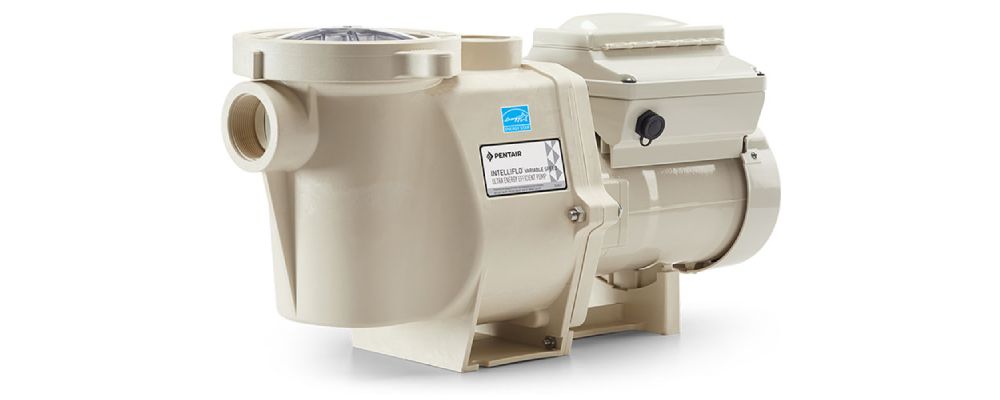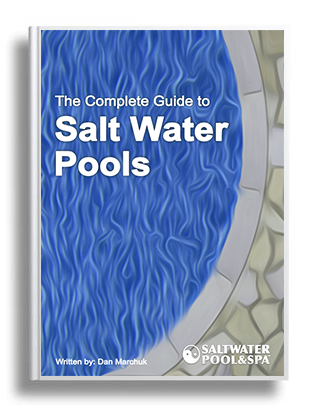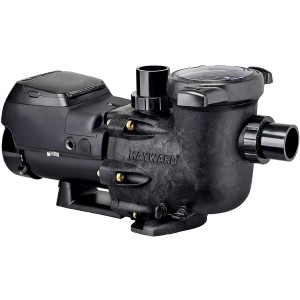- Salt Water Pool and Spa
- Pool Pumps
- Pool Pump Sizing
Pool Pump Sizing
Accurate pool pump sizing is extremely important if you are constructing a new swimming pool or trying to reduce electrical costs. It's important that you choose the right size pump for your pool to ensure that enough water is circulated to keep the water chlorinated, filtered and healthy for anyone enjoying the pool. As a salt water pool owner we highly recommend a variable speed pool pump and we'll explain the reasons below.

The pump is the heart of any swimming pool system and with a salt water system it's even more important to get your pump sized correctly. The chlorine generation in a salt water pool relies entirely on the salt water being circulated through the salt cell. The circulated water is converted into chlorine only when it passes through the cell and if you don't have enough turnover you will constantly find your chlorine production is too low.
The Complete Guide to Salt Water Pool MaintenanceEverything you need to know to maintain your salt water pool and keep it running smoothly all season. |
|
Pool Pump Sizing Step by Step
A common misconception is to purchase the largest pool pump you can find so that you know you have enough circulation for your pool. Although this is a good idea in theory it can lead to unnecessarily high electrical usage and can be very costly. The ideal pump will turnover your entire pool in an 8 hours cycle and since all pools are different it's important to get your pool pump sizing correct.
The larger the pump the more flow is generated and subsequently the faster turnover rate. Turnover rate is the period of time required to circulate a volume of water equal to the pool or spa capacity. If you trust that your current pump is properly sized you can replace with a similar hp pump but if you want to ensure you are using the best pump possible for your pool follow the sizing guidelines below.
We've put together a simple step by step guide to help you calculate what size pump is ideal for your pool. This will ensure that the pump is the most efficient size for your specific pool system. It will take a few minutes to work through these steps but it's worth every minute when you figure out the correct size pump to circulate your pool water while saving you money every month in electrical savings.
- Calculate Pool Volume
- Minimum Flow Rate
- Maximum Flow Rate
- Flow Rate Range
- Total Dynamic Head
- Final Range
1. Calculate Pool Volume
We first need to determine how many gallons of water are in your pool. This will help us figure out how much water needs to be circulated in an 8 hour period and give us an idea of the required turnover rate.
- Rectangular pool = length (ft) x width x average depth x 7.48
- Oval pool = ½ length (ft) x ½ width x average depth x 3.14 x 7.48
- Round pool = radius (ft) x radius x average depth x 3.14 x 7.48
If you would like to use a calculator to determine how many gallons are in your pool you can use the Pentair Pool Volume Calculator by following the link.
2. Minimum Flow Rate
After you have determined approximately how many gallons of water are in your pool we need to convert this into a rating of Gallons per Minute. We will assume that you want to achieve 2 complete turnovers per day which is recommended for salt water systems. If you want to run the pump less you will need to increase chlorine output on the chlorine generator.
- 16,200 gallons x 2 turnovers a day = 32,400 gallons per day
- 32,400 ÷ 24 hours = 1,350 gallons per hour
- 1,350 ÷ 60 minutes = 22.5 gallons per minute - GPM
We can see that a 16,200 gallon pool run 24 hours a day requires 22.5 GPM output.
If we want to achieve a complete turnover twice a day but want to run a 6, 8, or 10 hour cycle twice a day we can use the following calculations:
- 6 hour cycles x 2 = 45 GPM
- 8 hour cycles x 2 = 33.8 GPM
- 10 hour cycles x 2 = 27 GPM
The goal is to achieve the highest efficiency and the options are running a higher horsepower pump for shorter durations or a lower horsepower pump for longer duration. The advantage of running a low horsepower pump for longer periods is that your water chemistry is more balanced and you will create a more reliable and steady amount of chlorine from the salt cell.
This is where a variable speed pool pump comes in handy because you can run the pump at a low speed and increase the speed when you require more chlorine output or you need extra horsepower to operate a solar powered pool heater. You will not only notice substantial electrical savings but your pool will be healthier due to the constant circulation.
Pentair IntelliFlo Variable Speed Energy Efficient Pool PumpIf you click on this link and make a purchase, we may earn a commission. |
3. Maximum Flow Rate
Now that we have the minimum flow rate required to complete 2 turnovers a day we need to figure out the maximum flow rate. The maximum flow rate is limited by the length and diameter of the plumbing, pool equipment and additional features or accessories in your plumbing system. It is important not to exceed these limitations as it could cause damage to equipment, use excess electricity and pose a safety hazard.
Plumbing Maximum Flow Rates
There are a couple determining factors that will depict the maximum flow rate for your pool system. All plumbing is rated for maximum flow rate and essentially is how much pressure it is willing to withstand. The plumbing in your pool system has the recommended maximum flow rates.
- 1.5” Plumbing = 43 GPM
- 2” Plumbing = 73 GPM
- 2.5” Plumbing = 120 GPM
If we assume there are 2 – 2” lines from the skimmer and drain it would allow a 146 GPM maximum flow rate. If we have also have a spa that runs on 1 – 2” line the maximum flow rate would be 73 GPM. We need to take the lower of the two rates so the maximum flow rate for this pool system is 73 GPM.
Filter Maximum Flow Rates
The second limiting factor is the type of filter your are using with your pool system. A filter will work optimally when the flow rate is within the recommended rate for the model of pool filter you are using. If the flow rate is too low you won't get adequate filtration and if it is too high you could damage the filter or it won't filter properly.
Sand Filters
- 1.8 sq ft Surface area = 40 GPM Max Flow Rate
- 2.3 sq ft Surface area = 50 GPM Max Flow Rate
- 3.1 sq ft Surface area = 60 GPM Max Flow Rate
- 4.9 sq ft Surface area = 100 GPM Max Flow Rate
DE Filters
- 24 sq ft Surface area = 36 – 48 GPM
- 36 sq ft Surface area = 54 – 72 GPM
- 48 sq ft Surface area = 72 – 96 GPM
- 60 sq ft Surface area = 90 – 120 GPM
Cartridge Filters
- 100 sq ft Surface Area = 32 – 38 GPM
- 200 sq ft Surface Area = 55 – 75 GPM
- 300 sq ft Surface Area = 80 – 112 GPM
- 400 sq ft Surface Area = 100 – 150 GPM
Manufacturers may specify a maximum flow rate or ideal flow rate but it’s always a good idea to stay near the low end of the recommended rate for your pool filter. If you are using a sand filter it will work effectively at any rate that is under the maximum.
4. Flow Rate Range
Now that you know how to calculate the minimum and maximum flow rates for your pool system you can determine the flow rate range. If we use the example above we can determine the following:
A salt water pool with 16,200 gallons of water on a 24 hour cycle that completes 2 turnovers per day will require a minimum flow rate of 22.5 GPM.
If we assume we have 2" plumbing supplying our spa this limits us to 73 GPM. If we also assume we are using a 3.1 sq ft sand filter that has a maximum of 60 GPM we take the lower of the two rates and determine that our maximum flow rate is 60 GPM.
The flow rate range for our example pool system is 22.5-60 GPM
5. Total Dynamic Head (TDH)
Total dynamic head is the total resistance to the flow of water in your pool system and is caused by the pump, filter, plumbing and any other hardware or accessories you have installed. If you would like to determine the TDH for your pool you should visit our total dynamic head page that will help you figure this out.
In most residential in-ground pools you can expect between 50-60 TDH. In most above ground pools you can expect about 30 TDH. If you don't have any additional features or unique plumbing you can assume these numbers to be close to your pool's TDH.
6. Final Range and TDH
You have now completed your pool pump sizing and will be able to purchase a pool pump that will work efficiently and safely with your pool system. We can see that for our example pool we can determine the following:
- 22.5-60 GPM or Flow Rate Range
- 50-60 TDH or Feet of Head
When purchasing a pool pump each model will have a chart to determine the best Horse Power (HP) for your required Flow and TDH or Feet of Head.
Pool Pump Sizing Recommendations
If you are operating a salt water system and want the best efficiency while providing adequate chlorine production and circulation we have a few recommendations. The goal is to use the smallest and most energy efficient pump for your unique pool and system. A pool pump timer is an affordable device that will also help reduce operating costs while adding simplicity to your pool system.
If you use a low powered high efficiency pump and run it 24 hours it will cost less than running a larger pump. The pool will be under a constant low level of filtration and stay in perfect condition around the clock. Variable speed pool pumps or multi-speed pumps are becoming more popular because they can operate at a low setting for longer periods of time, consume less energy while keeping your pool sparkling clean and healthy.
If you operate a shared spa, in-floor cleaning system, solar heating system or pressure side cleaning system you may have to use a larger pump but for most pool owners we recommend a variable speed pump. A two speed pump may cover the increase in flow rate at different settings or you can possibly use a booster pump.
Disclaimer
Please use all appropriate and proper safety precautions when attempting projects on this website. All projects are attempted at the reader's own risk.
Salt Water Pool and Spa™ participates in the Amazon Services LLC Associates Program, as an Amazon Associate we may earn a commission from qualifying purchases.


